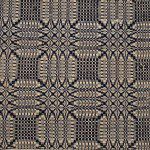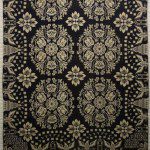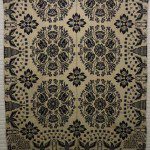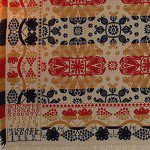Woven Coverlets: The Perfect Sleeper
By • July 16, 2015 0 5105
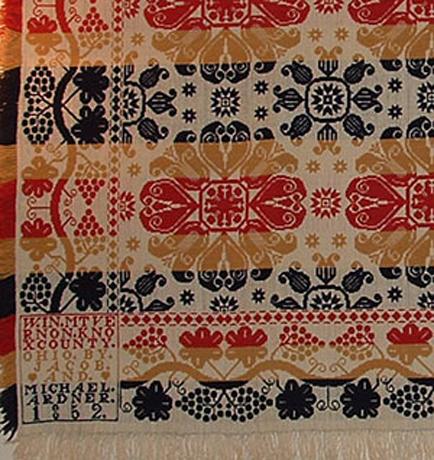
Sleeping was a textile-heavy experience in the 1800s. Textiles were a primary component of being able to sleep in a comfortable and warm environment. Beds were designed as fully draped enclosures, with curtains, valances and a coverlet. The coverlet was the topmost covering on the bed.
Until the 1820s, most coverlets were hand-loomed at home. Professionally woven coverlets gained popularity between 1820 and the Civil War — the majority were made between 1800 and the 1880s. Woven mostly by men, who trained as carpet weavers in England and Germany, then set up shops along the East Coast, these coverlets were affordable enough for rural and middle-class Americans.
Imported indigo and madder dyes, and other natural plant dyes, provided the pigment for most 19th-century coverlets. Bloodroot and dogwood produced red, bittersweet yielded orange and butternut bark produced brown. They were often made of a combination of wool and linen called linsey-woolsey — an important fabric in Colonial America due to the relative scarcity of wool. But some were made of bleached cotton.
The earliest coverlets were woven on a rather primitive “four harness” loom, which limited the weaver’s ability to produce complex patterns. The float work or overshot coverlet was woven in one long narrow piece, then cut width-wise and sewn together to make a textile wide enough for a bed.
In the early 1800s, the newly invented Jacquard loom made its way from France. The modernized technology — actually a loom attachment — allowed elaborate, complex patterns and images to be incorporated into coverlets. The coverlet progressed from a purely functional item, used primarily to provide privacy and warmth in early American homes, to one of aesthetic beauty.
These colorful coverlets displayed elaborate patterns, with images of birds and plants, and often the name of the owner and the weaver. Characteristic of many early woven coverlets were their interesting and informative inscriptions, which varied in placement, content and complexity. They could denote the weaver’s name, the location of the loom, the date, a bible verse or political slogan, a commemoration and sometimes the owner’s name. Usually the inscription was woven in backwards and forwards, allowing it to be read from either side of the coverlet.
Both men and women ordered and purchased coverlets. Since comparatively few weavers were women, when a woman’s name is inscribed into a coverlet, it is generally thought to be the owner’s name, not the weaver’s. But if a man’s name appears on a coverlet it could be the name of the owner or the weaver.
The prices of antique coverlets can span from a couple of hundred dollars to several thousand, depending on the design, condition and provenance. Antique coverlets were treasured by families through many generations, and were frequently mentioned in wills and stored for future descendants in dower chests. They are true American heirlooms.
Michelle Galler has been an antiques dealer and a consultant for more than 25 years. Her business is based in Rare Finds in Washington, Virginia. If you have questions or finds, email her at antiques.and.whimsies@gmail.com
- The patterns in figured and fancy coverlets are curvilinear and realistic and can include floral, animal, architectural and other motifs. Photo courtesy The National Museum of the American Coverlet.


